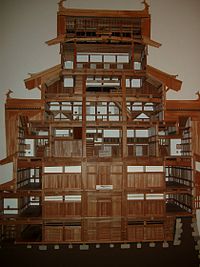- Nijūmon
-
Main article: Mon (architecture)
The nijūmon (二重門, lit. two story gate) is one of two types of two-story gate presently used in Japan (the other one being the rōmon, see photo in the gallery below), and can be found at most Japanese Buddhist temples.[1] This gate is distinguishable from its relative by the roof above the first floor which skirts the entire upper story, absent in a rōmon.[2] Accordingly, it has a series of brackets (tokyō) supporting the roof's eaves both at the first and at the second story.[3] In a rōmon, the brackets support a balcony. The tokyō are usually three-stepped (mitesaki) with tail rafters at the third step.[4][3] A nijūmon is normally covered by a hip-and-gable roof.[2]
Unlike a rōmon, whose second story is inaccessible and unusable, a nijūmon has stairs leading to the second story. Some gates have at their ends two sanrō (山廊), 2 x 1 bay structures housing the stairs.[2] The second story of a nijūmon usually contains statues of Shakyamuni or of goddess Kannon, and of the 16 Rakan, and hosts periodical religious ceremonies.[5] Large nijūmon' are 5 bays wide, 2 bays deep and have three entrances, however Tokyo's Zōjō-ji, the Tokugawa clan's funerary temple, has a gate which is 5 x 3 bays.[2] Smaller ones are 3 x 2 bays and have one, two or even three entrances.[2]
Of all temple gate types, the nujūmon has the highest status, and is accordingly used for important gates like the chūmon (middle gate) of ancient temples as Hōryū-ji.[3] The sanmon, the gate of a Zen temple of highest prestige, is usually a nijūmon.[note 1] Some nijūmon are called chūmon (中門?, lit. middle gate) because they are situated between the entrance and the temple.[2]
Contents
Gallery
-
A Niōmon of Kōmyō-ji in Ayabe
(National Treasure)
The second story of a nijūmon
Some interior images of the second story of a nijūmon, in this case Kōmyō-ji 's sanmon in Kamakura, Kanagawa prefecture.
Notes
- ^ The term sanmon originated at Zen temples, but is often used by other sects too, particularly by the Jōdo sect.
References
- ^ Fujita & Koga 2008, pp. 84–85
- ^ a b c d e f "nijuumon". JAANUS – Japanese Architecture and Art Net User System. http://www.aisf.or.jp/~jaanus//deta/n/nijuumon.htm. Retrieved 2010-06-22.
- ^ a b c Hamashima, Masashi (1999) (in Japanese). Jisha Kenchiku no Kanshō Kiso Chishiki. Tokyo: Shibundō. pp. 105–107.
- ^ For details, see the article Tokyō.
- ^ Iwanami Nihonshi Jiten
Bibliography
- Iwanami Nihonshi Jiten (岩波日本史辞典), CD-Rom Version. Iwanami Shoten, 1999-2001 (in Japanese)
- "Nijuumon". JAANUS – Japanese Architecture and Art Net User System. http://www.aisf.or.jp/~jaanus/deta/r/roumon.htm. Retrieved 2009-06-19.
- Fujita Masaya, Koga Shūsaku, ed (April 10, 1990) (in Japanese). Nihon Kenchiku-shi (September 30, 2008 ed.). Shōwa-dō. ISBN 4-8122-9805-9.
Elements of Japanese architecture Styles Buddhist · Buke · Daibutsuyō · Gassho · Giyōfū · Hachiman · Hirairi · Hiyoshi (also called Hie) · Irimoya · Ishi-no-ma · Kasuga · Kibitsu · Nagare · Ōbaku Zen · Setchūyō · Shinden · Shinmei · Shinto · Shoin · Sukiya · Sumiyoshi · Taisha · Wayō · ZenshūyōA model of Himeji Castle
Building types Roof styles Structural Burdock piling · Chigi · Disordered piling · Engawa · Fusuma · Hisashi · Irimoya-zukuri · Irori · Jinmaku · Katōmado · Katsuogi · Kuruwa · Mokoshi · Moya · Nakazonae · Namako wall · Nightingale floor · Onigawara · Ranma · Shōji (see also washi) · Sōrin · Tamagaki · Tatami · Tokonoma · Tokyō · Tsumairi · ShibiGates and approaches Rooms Furnishings Outdoor objects Measurements Groups See also Buddhist temples in Japan Japanese Buddhist architecture Architectonic elements Mon (gates) Buildings Chinjusha · chōzuya/temizuya · -dō · main hall (kon-dō, hon-dō, butsuden) · kuri · kyōzō or kyō-dō · shoinTō or Buttō (pagodas) Styles Others A-un · kenSchools and objects of worship Major schools Zen schools Nanto rokushū Objects of worship Amida Nyōrai · Benzaiten · Dainichi Nyorai · Jizō · Kannon · Marishi-ten · Shaka Nyorai · Shitennō (Four Kings) · Twelve Heavenly Generals (Jūni Shinshō) · Yakushi NyoraiOther elements Implements kei (ritual gong) · mokugyōOthers bussokuseki · butsudan · Glossary of Japanese Buddhism · Japanese Buddhist pantheon · jingū-ji · miyadera · saisenbakoCategories:- Gates in Japan
- Japanese architectural features
- Japanese architecture
- Buddhism in Japan
- Buddhist art and culture
-
Wikimedia Foundation. 2010.











